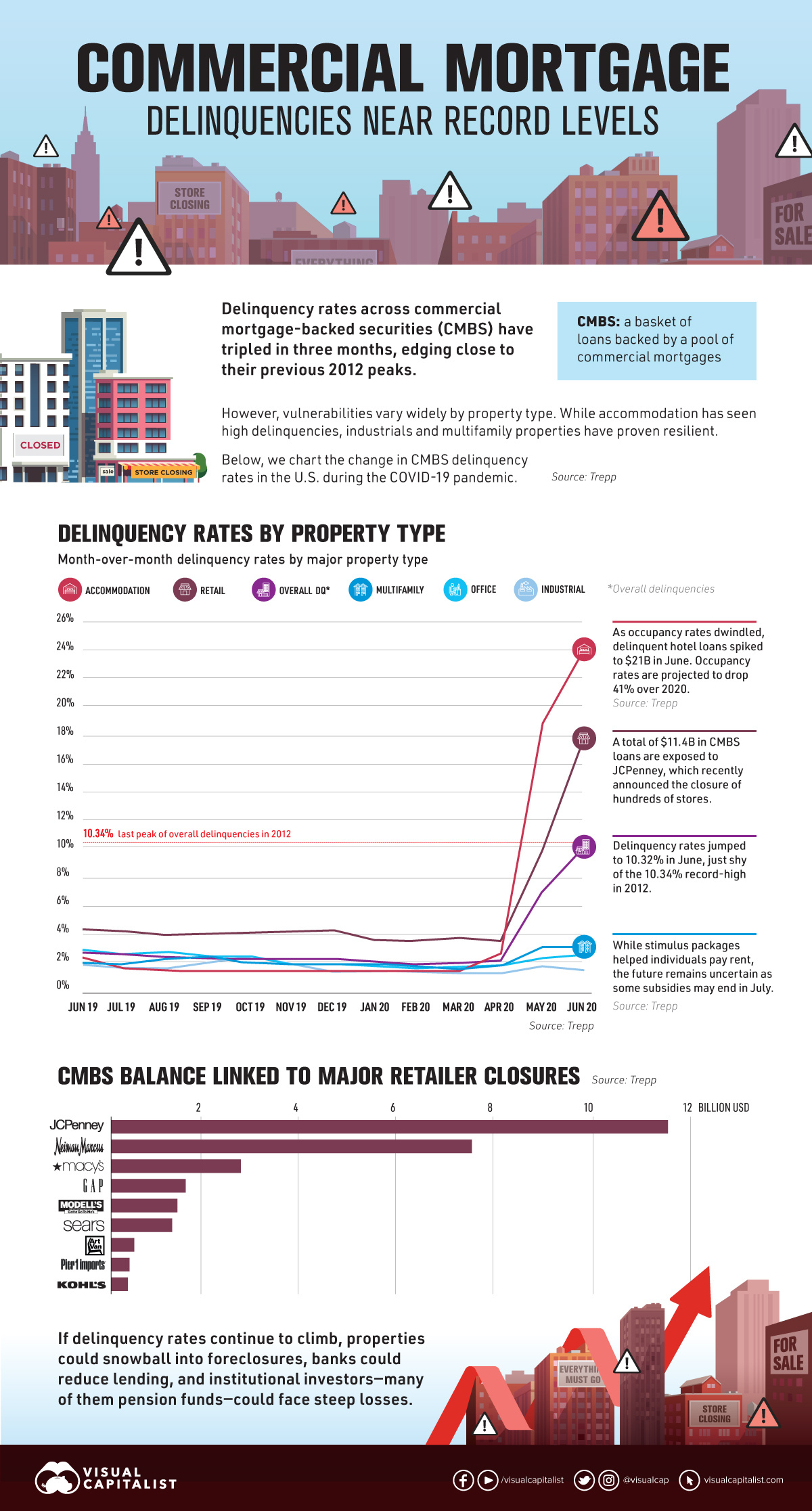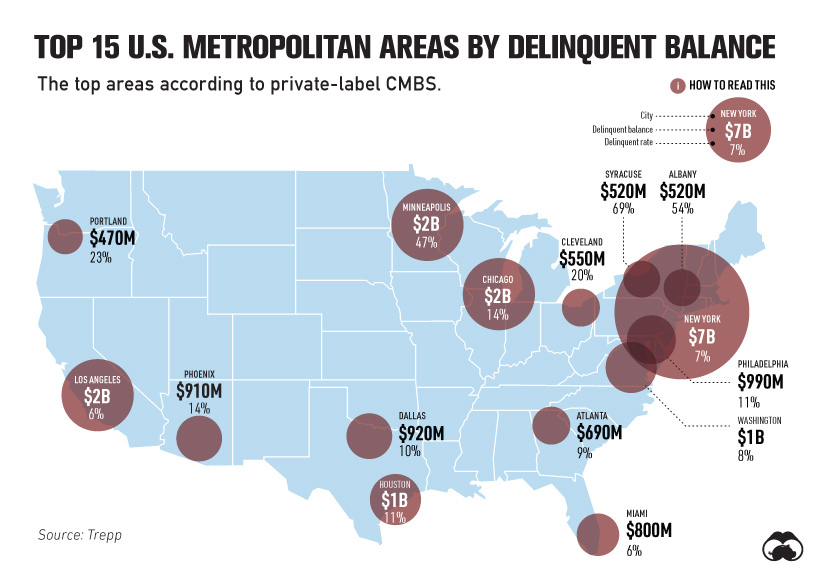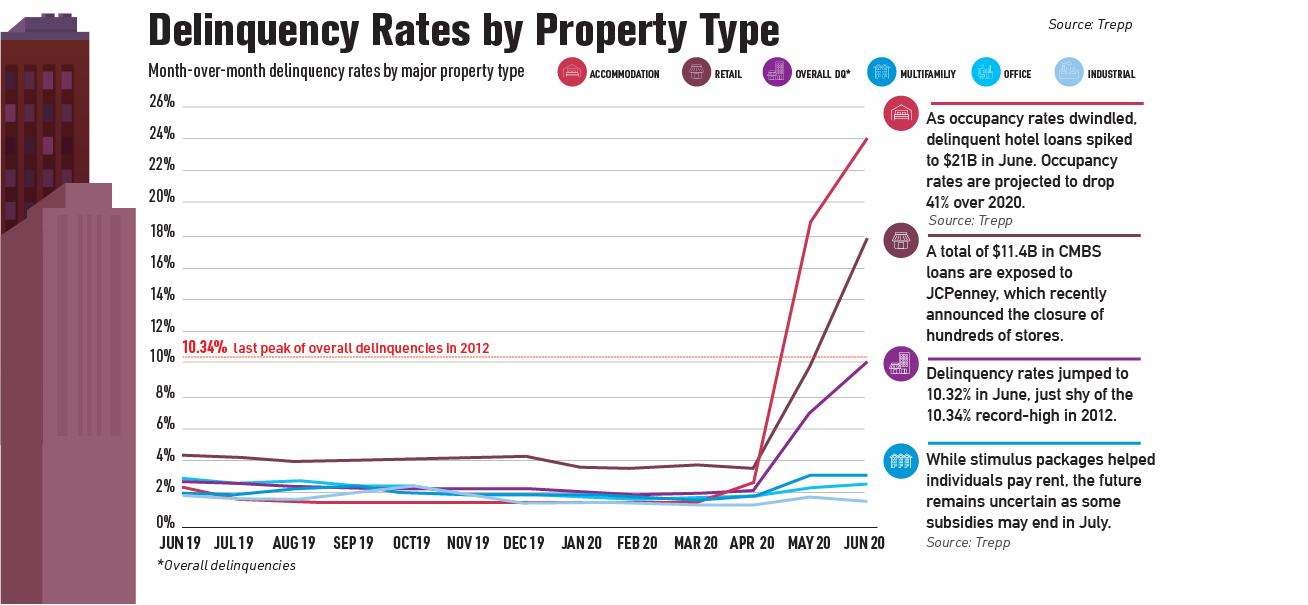Markets
Commercial Mortgage Delinquencies Near Record Levels

Commercial Mortgage Delinquencies Near Record Levels
Delinquency rates across commercial properties have shot up faster than at any other time.
As thousands of restaurants, hotels, and local businesses in the U.S. struggle to stay open, delinquency rates across commercial mortgage-backed securities (CMBS)—fixed income investments backed by a pool of commercial mortgages— have tripled in three months to 10.32%.
In just a few months, delinquency rates have already effectively reached their 2012 peaks. To put this in perspective, consider that it took well over two years for mortgage delinquency rates to reach the same historic levels in the aftermath of the housing crisis of 2009.
The above chart draws data from Trepp and illustrates the recent shocks to the CMBS market, broken down by property type.
Storm Rumblings
While there is optimism in some areas of the market, accommodation mortgages have witnessed delinquency rates soar over 24%.
Amid strict containment efforts in April, average revenues per room plummeted all the way to $16 per night—an 84% drop.
| Property Type | January 2020 | June 2020 |
|---|---|---|
| Accommodation | 1.5% | 24.3% |
| Retail | 3.8% | 18.1% |
| Multifamily | 2.0% | 3.3% |
| Office | 1.9% | 2.7% |
| Industrial | 1.6% | 1.6% |
| Overall | 2.1% | 10.3% |
Similarly, retail properties have been rattled. Almost one-fifth are in delinquencies. From January-June 2020, at least 15 major retailers have filed for bankruptcy and over $20 billion in CMBS loans have exposure to flailing chains such as JCPenney, Neiman Marcus, and Macy’s.
On the other hand, industrial property types have remained stable, hovering close to their January levels. This is likely attributable in part to the fact that the rise in e-commerce sales have helped support warehouse operations.
For multifamily and office buildings, Washington’s stimulus packages have helped renters to continue making payments thus far. Still, as the government considers ending stimulus packages in the near future, a lack of relief funding could spell trouble.
Weighing the Impact on U.S. Cities
How do delinquency rates vary across the top metropolitan areas in America?
Below, we can see that the delinquent balance and delinquency rates vary widely by city. Note that this data is for private-labeled CMBS, which are issued by investment banks and private entities rather than government agencies.

Despite the New York city metropolitan area having a delinquent balance of $7 billion, its delinquency rates fall on the lower end of the spectrum, at 7%. New York alone accounts for 18% of the total balance of private-label CMBS.
By comparison, the Syracuse metropolitan area has an eye-opening delinquency rate of 69%. Syracuse is home to the shopping complex, Destiny USA, which is facing tenant uncertainties due to COVID-19. The six-story mall attracts 26 million visitors annually.
Like the overall market, delinquencies are being driven by accommodation and retail properties across many of these U.S. metropolitan areas.
What Comes Next
What happens when delinquency rates get too high?
Often, when borrowers do not make payment after a reasonable amount of time, they enter into default. While time ranges can vary, defaults typically take place after at least 60 days of nonpayment. Between May and June, defaults in the CMBS market surged 792% to $5.5 billion.
As effects reverberate, properties could eventually fall into foreclosure. At the same time, institutional investors who own these types of securities, which include pensions, could begin seeing steep losses.
That said, the Federal Reserve has set up mechanisms to purchase CMBS loans with the highest credit quality. This is designed to inject liquidity into the mortgage market, while also financing small and mid-sized properties that house small businesses. In turn, this can enable the employment of millions of Americans.
Of course, it remains to be seen whether the mortgage market will face a sustained downturn akin to the financial crisis, or if the temporary decline will soon subside.
Maps
Mapped: The 10 U.S. States With the Lowest Real GDP Growth
In this graphic, we show where real GDP lagged the most across America in 2023 as high interest rates weighed on state economies.

The Top 10 U.S. States, by Lowest Real GDP Growth
This was originally posted on our Voronoi app. Download the app for free on iOS or Android and discover incredible data-driven charts from a variety of trusted sources.
While the U.S. economy defied expectations in 2023, posting 2.5% in real GDP growth, several states lagged behind.
Last year, oil-producing states led the pack in terms of real GDP growth across America, while the lowest growth was seen in states that were more sensitive to the impact of high interest rates, particularly due to slowdowns in the manufacturing and finance sectors.
This graphic shows the 10 states with the least robust real GDP growth in 2023, based on data from the Bureau of Economic Analysis.
Weakest State Economies in 2023
Below, we show the states with the slowest economic activity in inflation-adjusted terms, using chained 2017 dollars:
| Rank | State | Real GDP Growth 2023 YoY | Real GDP 2023 |
|---|---|---|---|
| 1 | Delaware | -1.2% | $74B |
| 2 | Wisconsin | +0.2% | $337B |
| 3 | New York | +0.7% | $1.8T |
| 4 | Missississippi | +0.7% | $115B |
| 5 | Georgia | +0.8% | $661B |
| 6 | Minnesota | +1.2% | $384B |
| 7 | New Hampshire | +1.2% | $91B |
| 8 | Ohio | +1.2% | $698B |
| 9 | Iowa | +1.3% | $200B |
| 10 | Illinois | +1.3% | $876B |
| U.S. | +2.5% | $22.4T |
Delaware witnessed the slowest growth in the country, with real GDP growth of -1.2% over the year as a sluggish finance and insurance sector dampened the state’s economy.
Like Delaware, the Midwestern state of Wisconsin also experienced declines across the finance and insurance sector, in addition to steep drops in the agriculture and manufacturing industries.
America’s third-biggest economy, New York, grew just 0.7% in 2023, falling far below the U.S. average. High interest rates took a toll on key sectors, with notable slowdowns in the construction and manufacturing sectors. In addition, falling home prices and a weaker job market contributed to slower economic growth.
Meanwhile, Georgia experienced the fifth-lowest real GDP growth rate. In March 2024, Rivian paused plans to build a $5 billion EV factory in Georgia, which was set to be one of the biggest economic development initiatives in the state in history.
These delays are likely to exacerbate setbacks for the state, however, both Kia and Hyundai have made significant investments in the EV industry, which could help boost Georgia’s manufacturing sector looking ahead.
-

 United States6 days ago
United States6 days agoMapped: Countries Where Recreational Cannabis is Legal
-

 Healthcare2 weeks ago
Healthcare2 weeks agoLife Expectancy by Region (1950-2050F)
-

 Markets2 weeks ago
Markets2 weeks agoThe Growth of a $1,000 Equity Investment, by Stock Market
-

 Markets2 weeks ago
Markets2 weeks agoMapped: Europe’s GDP Per Capita, by Country
-

 Money2 weeks ago
Money2 weeks agoCharted: What Frustrates Americans About the Tax System
-

 Technology2 weeks ago
Technology2 weeks agoCountries With the Highest Rates of Crypto Ownership
-

 Mining2 weeks ago
Mining2 weeks agoWhere the World’s Aluminum is Smelted, by Country
-

 Personal Finance1 week ago
Personal Finance1 week agoVisualizing the Tax Burden of Every U.S. State

 Can I share this graphic?
Can I share this graphic? When do I need a license?
When do I need a license? Interested in this piece?
Interested in this piece?













